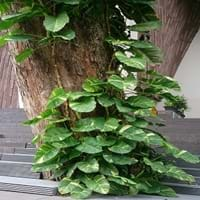Life Span
Perennial
Perennial
Type
Broadleaf Evergreen
Vines
Origin
Australia
Australia, China, India, Japan
Types
Bigleaf hydrangea, Hortensia, Smooth hydrangea, Oakleaf hydrangea, Annabelle
Marble Queen, species itself, Neon, all-green
Habitat
Forest edges, Hillside, Woods
Humid climates, Tropical regions
USDA Hardiness Zone
9-15
10-11
AHS Heat Zone
Not Available
12-10
Sunset Zone
21,22
Not available
Habit
Spreading
Prostrate/Trailing
Minimum Height
Not Available
Flower Color Modifier
Bicolor
Not Applicable
Fruit Color
Sandy Brown
Yellow Brown
Leaf Color in Spring
Green, Sea Green, Rose, Bronze
Yellow
Leaf Color in Summer
Green, Light Green
Light Green
Leaf Color in Fall
Green, Light Green, Gray Green
Light Green
Leaf Color in Winter
Green, Gray Green
Light Green
Leaf Shape
Oblovate
Ovate
Plant Season
Spring, Summer, Fall, Winter
All year
Sunlight
Full Sun, Partial Sun
Partial shade
Type of Soil
Loam, Sand
Loamy
The pH of Soil
Acidic, Neutral
Neutral
Soil Drainage
Well drained
Light
Bloom Time
Indeterminate
Mid Summer
Tolerances
Wet Site, Pollution, Drought, Salt, Soil Compaction
Dry soil, Shade areas, Sun
Where to Plant?
Container, Ground
Ground, Pot
How to Plant?
Seedlings, Stem Planting
Seedlings, Stem Planting
Plant Maintenance
Medium
Medium
Watering Requirements
Not Available
Do Not over Water, Never Over-water, Water when top layer of soil becomes dry
In Summer
Drought Tolerant
Lots of watering
In Spring
Moderate
Moderate
In Winter
Average Water
Less Watering
Soil pH
Acidic, Neutral
Neutral
Soil Type
Loam, Sand
Loam
Soil Drainage Capacity
Well drained
Average
Sun Exposure
Full Sun, Partial Sun
Full Sun, Partial Sun
Pruning
Remove damaged leaves, Remove dead branches, Remove dead leaves
Remove damaged leaves, Remove dead branches, Remove dead leaves
Fertilizers
All-Purpose Liquid Fertilizer
All-Purpose Liquid Fertilizer
Pests and Diseases
Red blotch
Mealybugs, Mites, Scale
Plant Tolerance
Wet Site, Pollution, Drought, Salt, Soil Compaction
Drought
Flowers
Showy
Insignificant
Flower Petal Number
Single
Not Available
Foliage Texture
Fine
Medium
Foliage Sheen
Matte
Glossy
Attracts
Bees, Flies
Insects
Allergy
Chest tightness, Diarrhea, Dizziness, Nausea, Vomiting
no allergic reactions
Aesthetic Uses
Not Available
Beautification, Cottage Garden, Landscape Designing, Showy Purposes
Beauty Benefits
Not Available
No Beauty Benefits
Edible Uses
Not Available
Yes
Environmental Uses
Air purification
Air purification, Food for insects, Provides ground cover
Medicinal Uses
Fever, Kidney problems, Urinary tract problems
ascites
Part of Plant Used
Flowers, Root
Stem
Other Uses
Not Available
NA
Used As Indoor Plant
Not Available
Yes
Used As Outdoor Plant
Yes
Yes
Garden Design
Container, Feature Plant, Hedges, Mixed Border, Screening, Wind Break, Topiary, Bonsai, Espalier, Tropical
Cutflower, Dried Flower/Everlasting, Mixed Border
Botanical Name
CALLISTEMON citrinus
Epipremnum aureum
Common Name
Crimson Bottlebrush
Hunter's robe, Money plant
In Hindi
Hydrangea
मनी प्लांट
In German
Hortensie
Geld-Anlage
In French
Hortensia
usine de l'argent
In Spanish
Hortensia
planta de dinero
In Greek
υδραγεία
φυτό χρήματα
In Portuguese
Hortênsia
planta de dinheiro
In Polish
Hortensja
pieniądze roślin
In Latin
Hibiscus
pecuniam herba
Phylum
Not Available
Magnoliophyta
Class
Not Available
Liliopsida
Order
Not Available
Alismatales
Family
Myrtaceae
Brassicaceae
Genus
Not Available
Epipremnum
Clade
Not Available
Angiosperms, Monocots
Tribe
Not Available
Monstereae
Subfamily
Not Available
Monsteroideae
Number of Species
Not Available
Difference Between Crimson Bottlebrush and Moneyplant
If you are confused whether Crimson Bottlebrush or Moneyplant are same, here are some features about those plants to help you choose better. Many people think that these two plants have the same characteristics, but one can see Crimson Bottlebrush and Moneyplant Information and learn more about it. Fertilizers required for proper growth of Crimson Bottlebrush are All-Purpose Liquid Fertilizer, whereas for Moneyplant fertilizers required are All-Purpose Liquid Fertilizer. Hence, one should know the basic difference between Crimson Bottlebrush and Moneyplant if you are planning to have them in your garden to enhance its beauty.
<
Flowering PlantsImportance of Crimson Bottlebrush and Moneyplant
Want to have the most appropriate plant for your garden? You might want to know the importance of Crimson Bottlebrush and Moneyplant. Basically, these two plants vary in many aspects. Compare Crimson Bottlebrush and Moneyplant as they differ in many characteristics such as their life, care, benefits, facts, etc. Every gardener must at least have the slightest clue about the plants he wants to plant in his garden. Compare their benefits, which differ in many ways like facts and uses. The medicinal use of Crimson Bottlebrush is Fever, Kidney problems and Urinary tract problems whereas of Moneyplant is ascites. Crimson Bottlebrush has beauty benefits as follows: Not Available while Moneyplant has beauty benefits as follows: Not Available.
Compare Facts of Crimson Bottlebrush vs Moneyplant
How to choose the best garden plant for your garden depending upon its facts? Here garden plant comparison will help you to solve this query. Compare the facts of Crimson Bottlebrush vs Moneyplant and know which one to choose. As garden plants have benefits and other uses, allergy is also a major drawback of plants for some people. Allergic reactions of Crimson Bottlebrush are Chest tightness, Diarrhea, Dizziness, Nausea and Vomiting whereas of Moneyplant have no allergic reactions respectively. Having a fruit bearing plant in your garden can be a plus point of your garden. Crimson Bottlebrush has no showy fruits and Moneyplant has no showy fruits. Also Crimson Bottlebrush is not flowering and Moneyplant is not flowering . You can compare Crimson Bottlebrush and Moneyplant facts and facts of other plants too.

